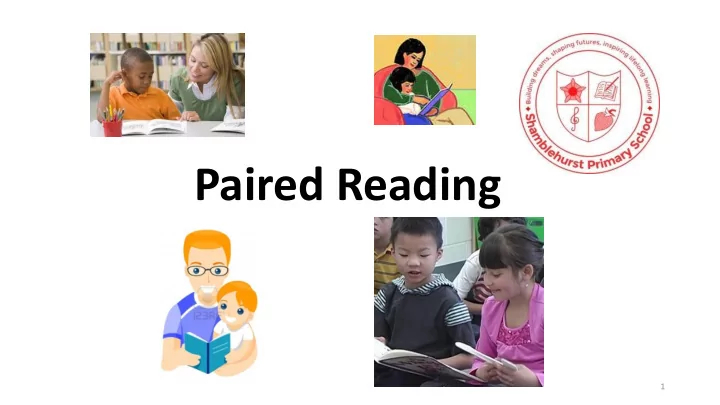

Paired Reading 1
Why Paired Reading? • Tried and tested – evidence based • Children feel empowered • Promotes reading for enjoyment • Increases confidence and self esteem • Encourages reading for meaning • Positive – focuses on successes not mistakes 2
Reading for pleasure Reading for pleasure is one of the biggest indicators of success in life • ‘Research evidence on reading for pleasure’ (2012) reported identified benefits in: reading attainment and writing ability text comprehension and grammar breadth of vocabulary positive reading attitudes self-confidence as a reader pleasure in reading in later life. general knowledge understanding of other cultures community participation insight into human nature and decision-making
Who is Paired Reading for? • Children who have already made a start with reading • Also very effective with older struggling or reluctant readers • Every child will benefit from using Paired Reading • It is not just for children with learning difficulties.
How do you do ‘Paired Reading’? 5
Children learn to Choosing what to read. read better from text that motivates them Let you child choose what to read 6
7
Before reading... • get comfortable • look at the cover • predict • talk about new words 8
read with your child – at the same pace if mistakes made, allow 5 you and seconds for child to correct your if not corrected, say word and child ask child to repeat correctly reading together Use praise Ask questions and discuss what you are reading 9
Child gives agreed signal. Praise for reading alone. Child reads alone. Ask questions when and discuss from time to time your If mistake is made, give 5 child is seconds to correct. reading alone If not corrected, you say word and ask your child to repeat correctly. read together again until your child signals to read alone. 10
During reading... • ask questions • discuss what they know -link to what they know already or thought before • encourage your child to work out the meaning of new words. 11
After reading... • ask questions • talk about what you have read • evaluate your reading 12
• Try really hard to do Paired • Remember you don’t need to Reading every day (at least 5 ask your child to ‘break up’ the times a week) word or ‘sound it out’. • Each Paired Reading session • If they are still struggling with a should be up to 10 minutes. word after 5 seconds say it for them then ask them to repeat it. • Only go over 10 minutes if your • Ensure your child points to the child wants to carry on. words in the text while they are • Don’t make children do Paired reading. Reading when they really want • Use lots of praise! to do something else.
Recommend
More recommend